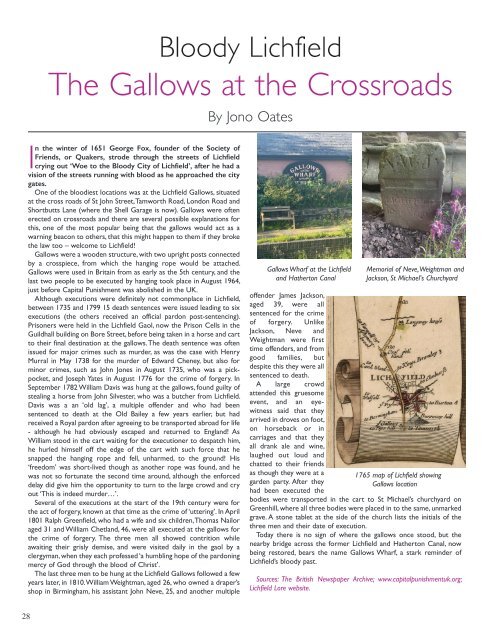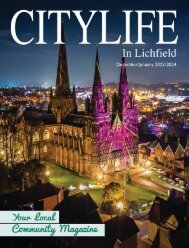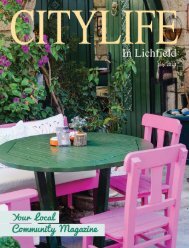Citylife in Lichfield June 2023
June brings sunshine, blue skies, warmer days, picnics, countryside walks, al fresco dining and those cool, Summer vibes! Our June edition is full of all the features that makes us the number one magazine in and around Lichfield - What's On events, competitions, local history articles, local community news and recipes. We also have some great ideas for gifts for Father's Day and also our 2023 Citylife Food Trail giving you details of all of the eateries, pubs, cafes, restaurants and takeaways in Lichfield city centre - and what is better than a combination of food, drink and sunshine while reading a copy of Citylife in Lichfield magazine this June - enjoy!
June brings sunshine, blue skies, warmer days, picnics, countryside walks, al fresco dining and those cool, Summer vibes! Our June edition is full of all the features that makes us the number one magazine in and around Lichfield - What's On events, competitions, local history articles, local community news and recipes. We also have some great ideas for gifts for Father's Day and also our 2023 Citylife Food Trail giving you details of all of the eateries, pubs, cafes, restaurants and takeaways in Lichfield city centre - and what is better than a combination of food, drink and sunshine while reading a copy of Citylife in Lichfield magazine this June - enjoy!
Create successful ePaper yourself
Turn your PDF publications into a flip-book with our unique Google optimized e-Paper software.
Bloody <strong>Lichfield</strong><br />
The Gallows at the Crossroads<br />
By Jono Oates<br />
In the w<strong>in</strong>ter of 1651 George Fox, founder of the Society of<br />
Friends, or Quakers, strode through the streets of <strong>Lichfield</strong><br />
cry<strong>in</strong>g out ‘Woe to the Bloody City of <strong>Lichfield</strong>’, after he had a<br />
vision of the streets runn<strong>in</strong>g with blood as he approached the city<br />
gates.<br />
One of the bloodiest locations was at the <strong>Lichfield</strong> Gallows, situated<br />
at the cross roads of St John Street, Tamworth Road, London Road and<br />
Shortbutts Lane (where the Shell Garage is now). Gallows were often<br />
erected on crossroads and there are several possible explanations for<br />
this, one of the most popular be<strong>in</strong>g that the gallows would act as a<br />
warn<strong>in</strong>g beacon to others, that this might happen to them if they broke<br />
the law too – welcome to <strong>Lichfield</strong>!<br />
Gallows were a wooden structure, with two upright posts connected<br />
by a crosspiece, from which the hang<strong>in</strong>g rope would be attached.<br />
Gallows were used <strong>in</strong> Brita<strong>in</strong> from as early as the 5th century, and the<br />
last two people to be executed by hang<strong>in</strong>g took place <strong>in</strong> August 1964,<br />
just before Capital Punishment was abolished <strong>in</strong> the UK.<br />
Although executions were def<strong>in</strong>itely not commonplace <strong>in</strong> <strong>Lichfield</strong>,<br />
between 1735 and 1799 15 death sentences were issued lead<strong>in</strong>g to six<br />
executions (the others received an official pardon post-sentenc<strong>in</strong>g).<br />
Prisoners were held <strong>in</strong> the <strong>Lichfield</strong> Gaol, now the Prison Cells <strong>in</strong> the<br />
Guildhall build<strong>in</strong>g on Bore Street, before be<strong>in</strong>g taken <strong>in</strong> a horse and cart<br />
to their f<strong>in</strong>al dest<strong>in</strong>ation at the gallows. The death sentence was often<br />
issued for major crimes such as murder, as was the case with Henry<br />
Murral <strong>in</strong> May 1738 for the murder of Edward Cheney, but also for<br />
m<strong>in</strong>or crimes, such as John Jones <strong>in</strong> August 1735, who was a pickpocket,<br />
and Joseph Yates <strong>in</strong> August 1776 for the crime of forgery. In<br />
September 1782 William Davis was hung at the gallows, found guilty of<br />
steal<strong>in</strong>g a horse from John Silvester, who was a butcher from <strong>Lichfield</strong>.<br />
Davis was a an ‘old lag’, a multiple offender and who had been<br />
sentenced to death at the Old Bailey a few years earlier, but had<br />
received a Royal pardon after agree<strong>in</strong>g to be transported abroad for life<br />
- although he had obviously escaped and returned to England! As<br />
William stood <strong>in</strong> the cart wait<strong>in</strong>g for the executioner to despatch him,<br />
he hurled himself off the edge of the cart with such force that he<br />
snapped the hang<strong>in</strong>g rope and fell, unharmed, to the ground! His<br />
‘freedom’ was short-lived though as another rope was found, and he<br />
was not so fortunate the second time around, although the enforced<br />
delay did give him the opportunity to turn to the large crowd and cry<br />
out ‘This is <strong>in</strong>deed murder…’.<br />
Several of the executions at the start of the 19th century were for<br />
the act of forgery, known at that time as the crime of ‘utter<strong>in</strong>g’. In April<br />
1801 Ralph Greenfield, who had a wife and six children, Thomas Nailor<br />
aged 31 and William Chetland, 46, were all executed at the gallows for<br />
the crime of forgery. The three men all showed contrition while<br />
await<strong>in</strong>g their grisly demise, and were visited daily <strong>in</strong> the gaol by a<br />
clergyman, when they each professed ‘a humbl<strong>in</strong>g hope of the pardon<strong>in</strong>g<br />
mercy of God through the blood of Christ’.<br />
The last three men to be hung at the <strong>Lichfield</strong> Gallows followed a few<br />
years later, <strong>in</strong> 1810. William Weightman, aged 26, who owned a draper’s<br />
shop <strong>in</strong> Birm<strong>in</strong>gham, his assistant John Neve, 25, and another multiple<br />
Gallows Wharf at the <strong>Lichfield</strong><br />
and Hatherton Canal<br />
offender James Jackson,<br />
aged 39, were all<br />
sentenced for the crime<br />
of forgery. Unlike<br />
Jackson, Neve and<br />
Weightman were first<br />
time offenders, and from<br />
good families, but<br />
despite this they were all<br />
sentenced to death.<br />
A large crowd<br />
attended this gruesome<br />
event, and an eyewitness<br />
said that they<br />
arrived <strong>in</strong> droves on foot,<br />
on horseback or <strong>in</strong><br />
carriages and that they<br />
all drank ale and w<strong>in</strong>e,<br />
laughed out loud and<br />
chatted to their friends<br />
as though they were at a<br />
garden party. After they<br />
had been executed the<br />
Memorial of Neve, Weightman and<br />
Jackson, St Michael's Churchyard<br />
1765 map of <strong>Lichfield</strong> show<strong>in</strong>g<br />
Gallows location<br />
bodies were transported <strong>in</strong> the cart to St Michael’s churchyard on<br />
Greenhill, where all three bodies were placed <strong>in</strong> to the same, unmarked<br />
grave. A stone tablet at the side of the church lists the <strong>in</strong>itials of the<br />
three men and their date of execution.<br />
Today there is no sign of where the gallows once stood, but the<br />
nearby bridge across the former <strong>Lichfield</strong> and Hatherton Canal, now<br />
be<strong>in</strong>g restored, bears the name Gallows Wharf, a stark rem<strong>in</strong>der of<br />
<strong>Lichfield</strong>’s bloody past.<br />
Sources: The British Newspaper Archive; www.capitalpunishmentuk.org;<br />
<strong>Lichfield</strong> Lore website.<br />
28

















